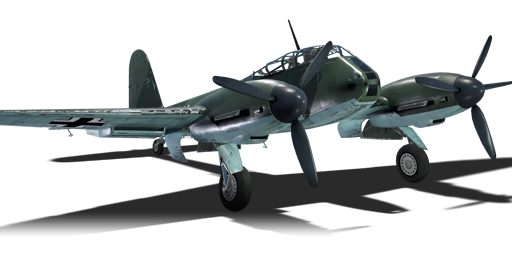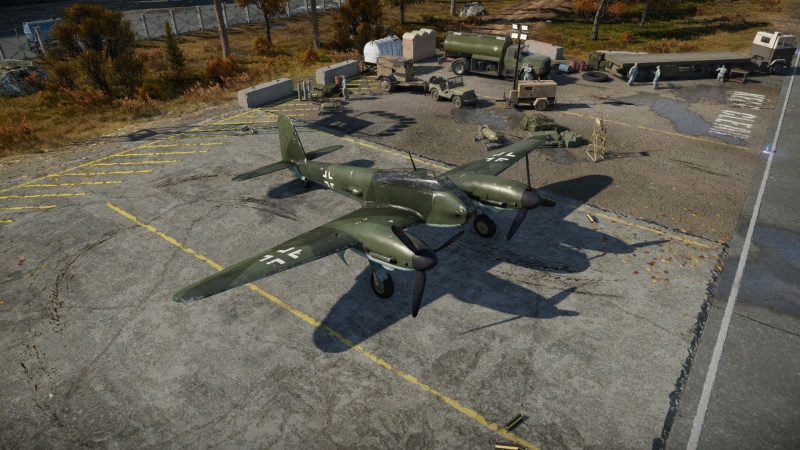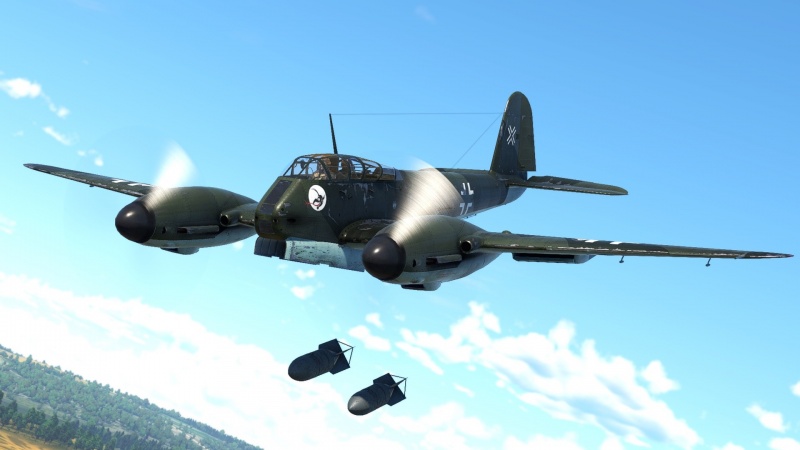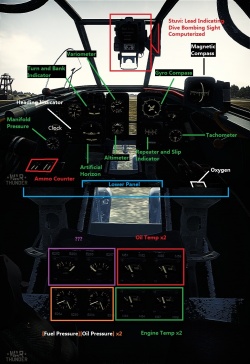Difference between revisions of "Me 410 A-1"
Colok76286 (talk | contribs) (Edits) |
m (Specs-Card ArtImage Added) |
||
| Line 6: | Line 6: | ||
{{Specs-Card | {{Specs-Card | ||
|code=me-410a-1 | |code=me-410a-1 | ||
| − | |images={{Specs-Card-Image|GarageImage_{{PAGENAME}}.jpg}} | + | |images={{Specs-Card-Image|GarageImage_{{PAGENAME}}.jpg|ArtImage_{{PAGENAME}}.jpg}} |
}} | }} | ||
Revision as of 02:59, 20 January 2023
| This page is about the German strike aircraft Me 410 A-1. For other versions, see Me 410 (Family). |
Contents
Description
The Me 410 A-1 is a rank III German strike aircraft with a battle rating of 3.3 (AB/RB) and 3.7 (SB). It has been in the game since the start of the Open Beta Test prior to Update 1.27.
General info
Flight performance
| Characteristics | Max Speed (km/h at 6,700 m) |
Max altitude (metres) |
Turn time (seconds) |
Rate of climb (metres/second) |
Take-off run (metres) | |||
|---|---|---|---|---|---|---|---|---|
| AB | RB | AB | RB | AB | RB | |||
| Stock | 602 | 584 | 10400 | 31.9 | 32.8 | 7.8 | 7.8 | 444 |
| Upgraded | 647 | 624 | 29.6 | 30.7 | 14.4 | 10.8 | ||
Details
| Features | ||||
|---|---|---|---|---|
| Combat flaps | Take-off flaps | Landing flaps | Air brakes | Arrestor gear |
| ✓ | ✓ | ✓ | ✓ | X |
| Limits | ||||||
|---|---|---|---|---|---|---|
| Wings (km/h) | Gear (km/h) | Flaps (km/h) | Max Static G | |||
| Combat | Take-off | Landing | + | - | ||
| 750 | 350 | 457 | 428 | 280 | ~12 | ~4 |
| Optimal velocities (km/h) | |||
|---|---|---|---|
| Ailerons | Rudder | Elevators | Radiator |
| < 390 | < 410 | < 460 | > 311 |
| Compressor (RB/SB) | ||
|---|---|---|
| Setting 1 | ||
| Optimal altitude | 100% Engine power | WEP Engine power |
| 5,300 m | 1,510 hp | 1,665 hp |
Survivability and armour
- 8 mm steel - front of cockpit (either side of the glass)
- 5 mm steel - wings leading edge (in front of fuel tanks)
- 8 mm steel - prop hub and gear bay
- 9 mm steel - top and bottoms of wings (around the liquid cooling system)
- 8 mm steel - plates in the tail
- 8 mm steel - bulkhead aft of gunner
- 8 mm steel - between gunner and pilot
- 12 mm steel - pilot's headrest
- 60 mm bulletproof glass - in front of the pilot (inside aircraft)
Modifications and economy
Armaments
Offensive armament
The Me 410 A-1 is armed with:
- 2 x 20 mm MG 151 cannons, nose-mounted (350 rpg = 700 total)
- 2 x 7.92 mm MG 17 machine guns, nose-mounted (1,000 rpg = 2,000 total)
Suspended armament
The Me 410 A-1 can be outfitted with the following ordnance:
- Without load
- 8 x 50 kg SC50JA bombs (400 kg total)
- 2 x 250 kg SC250JA bombs (500 kg total)
- 2 x 500 kg SC500K bombs (1,000 kg total)
Defensive armament
The Me 410 A-1 is defended by:
- 2 x 13 mm MG 131 machine gun, 2 x beam turrets (500 rpg)
Usage in battles
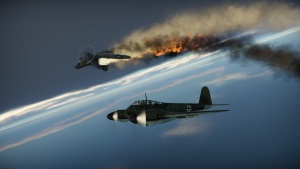
The Me 410 A-1 is the first variant unlocked of the Me 410 line-up of planes, succeeding the Do 217 fighter variants. Compared to Do 217, the Me 410 boasts significantly better flight performance in virtually all aspects and performs much more like an improved Bf 110 C-7. However, in the large spectrum of things, this doesn't really say a lot as the Me 410 gets pitted against even faster, more nimble and better armed single-engine fighters than its predecessors. Perhaps even more grievous of a pitfall, its armament of 2 x 7.92 mm MG 15 machine guns and 2 x 20 mm MG 151 cannons hardly outgun conventional fighters. A small but nonetheless noticeable plus is that defensive armament has very good coverage of the entire rear of the aircraft besides the immediate area behind the tail boom.
The Me 410 A-1, like the Do 217 and the Bf 110 C-7, is completely committed to boom and zoom tactics, and just like the predecessors, is useless at absolutely everything else. Trying to retain energy and knowing where your friends and enemies are is key to surviving in the aircraft. This also means, just like with the previous heavy fighters, that you should never commit to following a certain enemy. If an enemy is starting to turn off to the point where you need to use elevators to assist you in a turn, you will be burning far too much energy and make yourself easy prey for more nimble fighters.
Manual Engine Control
| MEC elements | ||||||
|---|---|---|---|---|---|---|
| Mixer | Pitch | Radiator | Supercharger | Turbocharger | ||
| Oil | Water | Type | ||||
| Not controllable | Controllable Auto control available |
Not controllable Not auto controlled |
Controllable Not auto controlled |
Combined | Not controllable 1 gear |
Not controllable |
Pros and cons
Pros:
- Nose-mounted armament gives a very dense cone of fire
- Good traverse arcs for the 13 mm machine guns
- Reasonably fast for a twin-engine fighter
- Has air brake
- Larger ammo capacity than conventional fighters
- Significantly more manoeuvrable than the Do 217 fighters
- Capable of mounting a decent amount of bombs (for a fighter) by default in the internal bomb bay
Cons:
- Large target for enemy aircraft
- Subpar manoeuvrability; even a few bombers can out-turn it
- Pilot can be vulnerable in a head-on attack
- Defensive armament cannot shoot directly behind the aircraft, leaving a very critical blindspot in the coverage
- Slow, a sitting duck if caught in a low energy state
- Compresses easily at high speeds
- Wings rip easily at high speeds in RB/SB
History
The Me 410 was developed from the Me 210. The Me 210 had many aerodynamic flaws which were exploited by the more nimble Hawker Typhoons. The Me 410 was a redesign of the Me 210 which included a lengthened fuselage, more powerful Daimler-Benz DB603A engines, and larger wing surface area. Most importantly, the installation of automatic slats greatly improved handling characteristics. Early versions of the Me 410 were designed as fast night and day bombers but quickly fell prey to better British night fighters. In the role of a heavy fighter, the Me 410 was used to attack US day-bomber combat box formations, equipped with 50 mm BK cannons or 210 mm Werfer-Granate rocket tubes. These modifications made the Me 410 rather clumsy and unmanoeuvrable. This made them easy targets to the bomber's escorts, fast and agile Spitfires or P-51 Mustangs. The Me 410 often worked in co-operation with Bf 110s. In the closing stages of World War II, many Me 410s were used as homeland defence or tactical reconnaissance.
| Archive of the in-game description | |
|---|---|
|
The pressing need to replace the obsolete Bf 110 and the unsuccessful Me.210 in the Luftwaffe's squadrons became reason for Messerschmitt AG to create a new twin-engine heavy fighter. It was decided that this aircraft be based on the Me.210 so that its production could use available manufacturing equipment and components and accessories which were in stock. In addition, this approach made it easier for the flight crews to master the new aircraft. Although it would have been more logical to keep the previous designation and only add a variant letter, the Me.210 had such a bad reputation that it was decided to replace its designation with a new one, "Me.410". The Me.410V-1 prototype was redesigned from the Me.210A-0. Testing began in the autumn of 1942, and full-scale production of the Me.410A was launched in January 1943. The length of the Me.410's fuselage was changed, and significant changes were introduced to the wing structure; in particular, the leading-edge sweep was reduced by 5 degrees. Leading edge slats were mounted, the aerodynamics of the radiators were slightly improved, and the shape of the wing flaps was changed. The most unique characteristic of the Me.410 was new high-powered 1,750 hp Daimler-Benz DB 603A twelve-cylinder, liquid-cooled engines with VDM three-bladed, controllable-pitch propellers. When compared to the Me.210, the Me.410's controllability was much improved, as the aircraft no longer tended to suddenly go into a spin. The flight characteristics were significantly higher than those of the Bf 110. Two aircraft variants in the series were built simultaneously: a high-speed Me.410A-1 bomber and a Me.410A-2 "destroyer" (Zerstörer). Both variants had the same armament, similar to that of the Me.210A-1. One 1,000 kg PC 1000, SD 1000, or SC 1000 bomb, two 500 kg bombs, or eight 50 kg bombs could be suspended in the bomb bay. The plane's standard bomb load was determined to be 500 kg. The Me.410A-1 was equipped with a special Stuvi 5B sight for dive bombing and tandem pairs of ETC bomb racks under the wing roots with four 50 kg bombs, two under each panel. Two 250 kg bombs could be suspended under the wings with the help of special Aussen ETC shackles. | |
Media
- Skins
See also
Links to the articles on the War Thunder Wiki that you think will be useful for the reader, for example:
- reference to the series of the aircraft;
- links to approximate analogues of other nations and research trees.
External links
| Germany strike aircraft | |
|---|---|
| Messerschmitt | |
| Bf 110 | Bf 110 C-6 · Bf 110 C-7 · Bf 110 F-2 · Bf 110 G-2 · Bf 110 G-4 |
| Me 410 | Me 410 A-1 · Me 410 A-1/U4 · Me 410 B-1 · Me 410 B-2/U4 · Me 410 B-6/R3 |
| Dornier | |
| Do 335 | Do 335 A-0 · Do 335 A-1 · Do 335 B-2 |
| Focke-Wulf | |
| Fw 190 | Fw 190 F-8 |
| Heinkel | |
| He 219 | He 219 A-7 |
| Henschel | |
| Hs 129 | Hs 129 B-2 · Hs 129 B-2 (Romania) · Hs 129 B-3 |
| Junkers | |
| Ju 87 | Ju 87 G-1 · Ju 87 G-2 |
| Foreign: | |
| USSR | ▀IL-2 (1942) |


